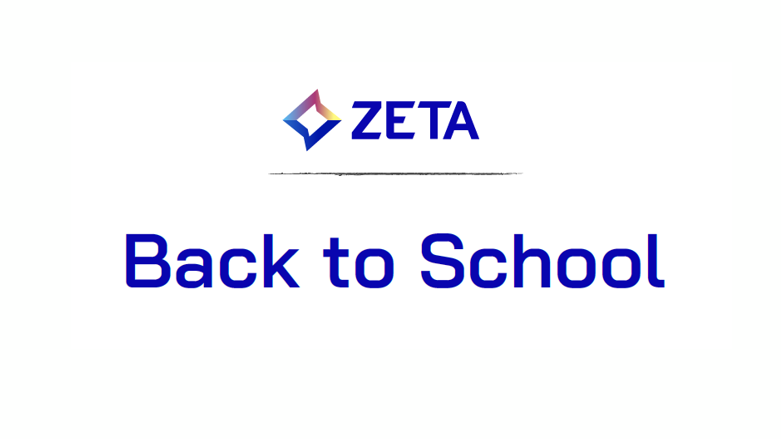
7 Pivotal Back-to-School Shopping Trends for 2022
More three-ring binders and number two pencils on the shelves can only mean one thing: it’s back-to-school shopping season. This time of year tends to be both exciting and stressful for parents. Some fall in the camp of counting down the days until they can have an empty house again, while any are more concerned about the scramble to get their children outfitted and supplied for school, and how much it will cost. This rings especially true this year, with the recession and skyrocketing inflation adding concerns around affordability and available inventory. To help better articulate what you can expect this back-to-school season, we sat down with Melissa Tatoris, Zeta’s VP of Retail, to delve into our own performance data and deliver seven fool-proof ways to more effectively reach and convert your target audiences.
Price Is King
Weighing on all consumers right now is a looming recession and the inflationary economy we’ve been saddled with for months. This has, understandably, led many shoppers to be more discerning about how they spend their money. Unlike the bygone days of stimulus checks, , price is now king among nearly every consumer base. We found that the majority of back-to-school shoppers plan to spend only $100-$300 this season. In light of this, marketers need to leverage technologies that showcase the affordability of their products. There are a few different ways to go about this.
The first is to employ scraping tools across the internet that will provide competitor data so that you can ensure your products are either beating or matching those prices. You can leverage this data in your marketing communications or offer a price-match guarantee. But don’t go about this lackadaisically. Outsource a vendor to help you identify which of your customers are incentivized to purchase based on discounts and price drops, and those who would have likely purchased regardless. Personalize your marketing to each of these audiences to ensure the highest probability of a conversion taking place. Another interesting thing to note — we noticed that shoppers who plan to only make purchases online had larger budgets averaging over $1,000.. If you’re online-focused, make sure to factor this into your strategy.
Value Eclipses Loyalty
There are a few trends that persist during economic downturns like the one we’re currently faced with. A huge one to consider is the impact this has on brand loyalty. Consumers tend to shift their focus toward the value that a product will provide to them versus maintaining loyalty to a brand. This means that the buyers that marketers could once rely on for repeat purchases may not be as reliable anymore — opting instead for a better deal. So, how do marketers navigate this shift?
Invest the time to focus on your best customers. Losing their lifetime commitment to your brand will do a lot more damage to your business than losing a one-time or new customer. Employ a hyper-personalized solution based on specific actions they’ve taken, or products they’ve viewed. This will personalize their experience and prove that you really value them as a customer. You’ll also need a better understanding of where else your consumers’ money is being spent. Is it with a competitor? For example, we noticed that nearly a third of consumers with budgets under $300 plan to shop in big-box stores. With limited budgets, there is a limited window to attract their business this season. Vendors like Zeta can help you do this. By recognizing their shopping behaviors, you’ll be able to better tailor your messaging to a specific consumer and reclaim their brand loyalty.
Shift in brand buying
The trend of buying local or according to a logo/brand affinity has given way to with a focus on big box stores that provide convenience and affordable pricing. This doesn’t have to be scary for marketers.
It’s time to shift your focus from brand marketing to accentuating the value that you provide. Focus on things like the quality of your products, the pricing compared to competitors, or customer testimonials customers. If you offer generic brands, be sure to highlight those as well. If you don’t carry generic brands, split your audience into regular buyers vs. those who are just bargain hunting. You can continue to market your non-generic products to those who regularly buy from you and focus on advertising your pricing to the latter audience. It’s crucial that you have a capable CDP vendor to execute this successfully. If your product is on the pricier side, it’s not game over. Play up features like your exclusivity or sustainability.
Christmas in July
It’s Christmas in July, and college-ruled notebooks are topping the wish lists! Historically we’ve seen the majority of back-to-school shopping in the months of August or September, but this year consumers are focusing more of their efforts earlier in the summer. How can your brand capitalize on this?
Users are conditioned to look for discounts and frequently, are impulsive to act on a deal so that they don’t miss out. Not only that, but the pandemic has introduced supply chain delays and inventory shortages. All of this has prompted consumers to begin shopping earlier in the summer season, with 50% planning to start loading their carts by late July.
Prepare for Inventory Issues
Out of stocks are invariable for even the most prepared retailers. Even still, there are ways to mitigate this risk and improve the overall customer experience. If an item has gone out of stock, the most important thing is to ensure that you aren’t losing the sale. Leverage your webpage, email, or SMS to highlight similar products and sustain their interest Timing is everything — you’ll want to act fast before they run off to a competitor.
We’ve noticed a lot of omnichannel businesses overlooking the in-store experience when there is an out-of-stock item. Leveraging QR codes throughout your store provides an opportunity for engagement where customers can look into the availability of a product or explore similar items of interest. Ensure that your stores are equipped with adequate Wi-Fi to make this a seamless experience. Finally, use visual messaging to guide shoppers to your online ‘endless aisle. This reminds them that even if a product is sold out in-store, it may be available for purchase online.
Capture Eye Share
Keep their eyes on the prize — your brand. Do so by leveraging all of your available channels to increase the reach of your discounts, deals, and product offerings. Working with a vendor like Zeta offers you the ability to market to customers and prospects via SMS. Text your audience when they’re near one of your stores. Or, shoot them a message when you’re running a promotion when they’re in-store to increase the likelihood that they make a purchase before leaving.
Don’t forget about your social channels. It’s reported that nearly half of social media users over 14 and one third of all internet users at large will make a purchase through social. Not only can you leverage your social channels to promote a deal, but most of these channels enable you to sell directly to your customers without them leaving the platform. Utilize this to cut down on the number of steps it takes to convert.
Labor Shortages
Labor shortages from production all the way to in-store sales will likely mean delays in shipping and receipt of product. It’s better to be transparent with your customers about out-of-stock items and expected delivery times. Proper expectation management will improve the brand experience. Perhaps even more crucial is staying in communication with your customers and prospects, including relaying when products come back in stock. Re-engage your audience through email and SMS to let them know when a product they may have viewed or tried to buy is available again.
Conclusion
With inflation still at an all-time high and potential labor shortages on the horizon, back-to-school season in 2022 means that brands will need to really hone their marketing strategy. These are some key takeaways to focus on this year:
- Use the back-to-school season as a bellwether for Holiday 2022. Increase the number of customers in your CRM so you’ll have a larger audience when the holidays roll around.
- Capture the sale by whatever means necessary. Price, promotion, and placement are making a come-back. Recreate a stronger in-store experience with things like high-energy music or free gifts. This will also help to bring back buyers for the holidays.
- Make your brand easy to do business with. Employ things like BOPIS, transparent shipping, bot-free customer service, and easy returns to close your sale.
- Get to know the competitor landscape ASAP. Understanding where else your consumers shop will help you better target them with the products they’re most likely to want or need.
Increase your chances of success by working with a partner like Zeta. We can help you navigate these rough waters using our internal cache of retail experts and industry-leading product suite. If you’d like to learn more about how Zeta can help you, reach out to one of our experts today.


